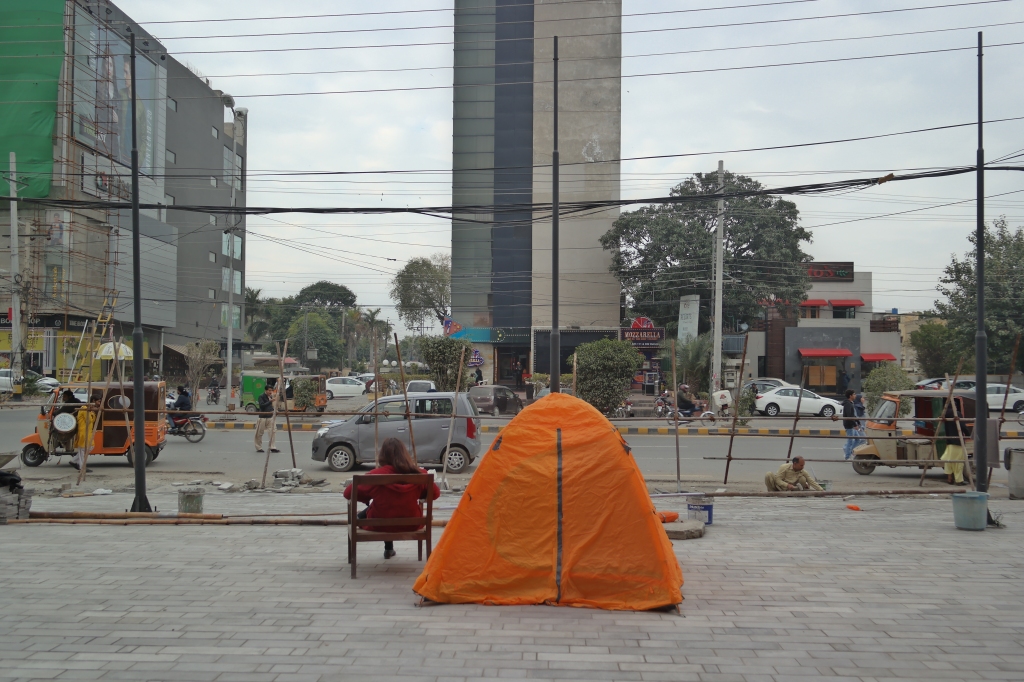Taking Cabbage for a Walk in Srinagar
- zaidisobia
- Aug 14, 2019
- 4 min read

Cabbage Walker walking his cabbage on a leash in Lal Chowk square Srinagar
I came in contact with this image in early 2016, through a source on internet that talked about a man walking his cabbage in Srinagar. I was so intrigued by the work that I made it part of my Poetics of Resistance class and we discuss the work and its intelligence while discussing the interventionist, public, protest performances.
He called himself “The Cabbage Walker” and his identity still remains undeclared due to the potential life threat for doing something so brave under the given circumstances. “I walked my cabbage in Lal Chowk amidst armed personnel,” he said in an interview, “and they could have beaten me, shot me, or taken me in for interrogation and whatnot, and I was mentally prepared for all those consequences. That reflects what Kashmiris have to face in Kashmir.”
In an attempt to “infiltrate peace into a zone of war” and to show that walking a cabbage on a winter’s day in Srinagar is more logical than the permanent war, this Kashmiri artist dressed in traditional Pehran pulled a cabbage on a leash through Lal Chowk, “a famous hangout spot for youngsters, the square is also the part of town where people go to make political statements. Separatist militants have also chosen the square to stage violent attacks. There are both strolling visitors and members of the armed forces present in Lal Chowk at any given time.”

Cabbage Walker walking through Srinagar
The absurdity of the act is what makes it all the more intelligent. For some people the act of walking your vegetable might sound bizarre, it’s not even normal or mundane but that’s the point. If you remove the cabbage it is mundane and normal. It only becomes absurd when you throw in a cabbage. So it was not a coincidence. The cabbage is the most essential and significant decision. The absurdity is the only thing that the artist finds around him and sees everywhere that has been normalized as trivial and part of the daily life. It is okay for people to be pointed guns at, to be killed and be under constant scrutiny and threat as part of their normal lives but walking a cabbage is not. In what can be called a manifesto the Cabbage Walker declared “I, as a Kashmiri, am willing to recognize walking the cabbage as part of the Kashmiri landscape, but I will never accept the check posts, the bunkers, the army camps, the torture centers, the barbed wire, the curfews, the arrests, the toxic environment of conflict and war, as part of the same.”

Han Bing, Walking the Cabbage in Tiananmen, Han Bing Art.
Although not the original idea but a continuation or an offshoot of Han Bing’s Walking the Cabbage Series and was adapted by the permission of the artist by the Kashmiri Cabbage Walker, the work is intelligent also original in so many ways. It checks all the right boxes. As a performance act, it is very engaging due to the props used and the site selected which is very political and an act like this is something highly unlikely to happen there. Although absurd in nature but makes perfect sense, when placed in its context. It is a public performance but I love the textures and layers of meanings and sense of anonymity, the childlike playfulness and secrecy attached to it. It’s a political act in disguise, in fact it’s a perfect example of the politics of “disguise and anonymity” as stated by Scott that takes place only in views of public and is designed to have a double meaning in order to hide the actors. The performance happened in Lal Chowk in front of soldiers armed with guns. And the artist says that “It was confrontational — their guns versus my cabbage on a leash. Their position of war, versus my position of peace.” This is a very big political statement in my view. Artist never claimed that he was trying to articulate something new with this performance, he says that he is just iterating the sentiments and thoughts of the Kashmiris. The work very playfully mocks the most powerful institution and its discourse.
This performance act reminds us that how our negotiations to create alternative worlds for ourselves can be imagined and briefly materialized by art and that artists have a responsibility to tell the truth…the truth of their time and their truth, their convictions through art and that art has the ability to do that. While I see all the images from Kashmir today I keep going back to this image and the absurdity of the war. In an online interview that I accessed in 2016 the artist while talking about a bullet hole in one of the walls of the house he grew up in said “It is a marker of this conflict, this war that has invaded the private space of our homes, I wish I could call it the residue of war, but I can’t…the militarization itself, is ever-present.”
I am writing this in 2019 and sadly I still can’t call it “the residue of war”, because militarization is “ever- present” and ever-growing, as absurd as Walking a Vegetable on a leash.



Comments